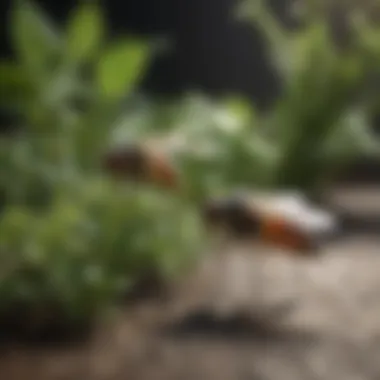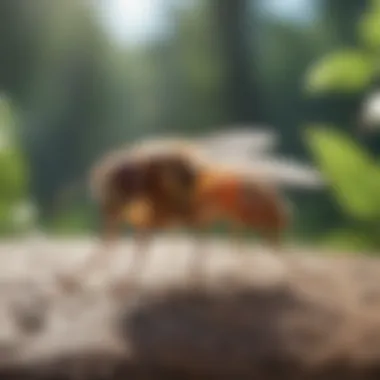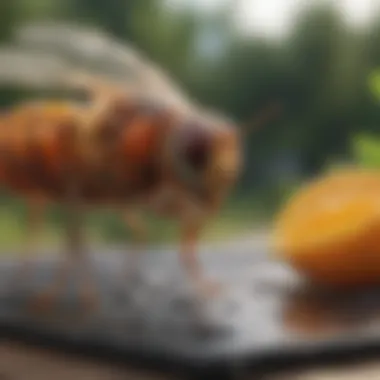Top Home Remedies to Banish Fruit Flies Effectively


Intro
Fruit flies, known scientifically as Drosophila melanogaster, are tiny insects that can quickly become a nuisance in homes. These pests thrive in environments where ripened fruits and vegetables are present. Their rapid breeding cycle allows them to reproduce in large numbers, making their elimination from the home a priority for many. While chemical solutions exist, many prefer to explore home remedies that are effective, safe, and environmentally friendly.
The focus of this article is to equip readers with practical methods that can be easily implemented to combat fruit fly infestations. By understanding their behavior and nature, one can apply targeted strategies that not only eliminate the flies but also prevent their return. The remedies discussed herein aim to restore harmony to living spaces without the use of harsh chemicals.
Animal Profile
General Overview
Fruit flies are small, fast-flying insects that are often brownish in color and have distinctive red eyes. They are particularly attracted to fermented or decaying produce. Adult fruit flies can lay hundreds of eggs on a food source, which will hatch into larvae within a day. The life cycle is rapid, and within a week, the new generation is ready to mate and lay their own eggs.
Habitat and Distribution
These flies are found in various environments around the world, including homes, grocery stores, and restaurants. They flourish in warm environments, often gravitating towards materials that have begun to decompose. Their distribution is widespread, meaning they can be encountered in urban and rural settings alike.
Understanding the Problem
An understanding of fruit fly behavior is crucial in managing their presence. They are drawn to moisture and sugary substances. Keeping areas where food is stored, prepared, or consumed clean is vital. It is essential to seal containers and dispose of overripe food promptly.
Effective Home Remedies
- Apple Cider Vinegar Trap: Fill a jar with apple cider vinegar and cover it with plastic wrap, securing it with a rubber band. Puncture small holes in the cover; the sweet scent attracts fruit flies, which then become trapped.
- Wine Trap: Similar to the vinegar trap, leftover red wine can be used. Pour some wine in a jar and cover it similarly with plastic wrap.
- Soap and Water: Mixing soap with water can create a solution for spraying directly on the flies. This method causes them to get stuck and die.
- Basil Leaves: Strategic placement of fresh basil leaves around the house can deter fruit flies, as they are averse to the scent.
Preventive Measures
To reduce the likelihood of future infestations, one must adopt preventive strategies. Here are a few:
- Maintain cleanliness in the kitchen, ensuring no food is left exposed.
- Regularly check and reseal produce to mitigate the attraction for flies.
- Address any leaks and standing water where flies might breed.
Closure
Fruit flies may be small, but their impact in a home can be considerable. By employing the remedies discussed, one can effectively reduce their numbers and keep them from returning. Understanding their habits and environment is key in this battle. A combined approach of elimination and prevention will definitely allow for a more peaceful home environment without the encumbering presence of fruit flies.
The most effective strategy against fruit flies is maintenance. Keeping spaces clean and monitoring for potential breeding grounds are essential to keeping them at bay.
Understanding Fruit Flies
Fruit flies, known scientifically as Drosophila melanogaster, are common household pests. Their presence can create a sense of discomfort and indicate deeper issues in the domestic setting. Understanding fruit flies is essential in developing effective home remedies to combat their intrusion. This section evaluates their biology, life cycle, and attraction to common items in our environment.
Biology and Behavior
Fruit flies are small flying insects, typically measuring around 1/8 inch in length. They possess a distinctive appearance with large red eyes and tan bodies. Understanding their biology helps comprehend their behavior, especially their attraction to fermenting substances. These flies are attracted to overripe fruits, vegetables, and sometimes even spilled drinks.
They exhibit a behavior called lekking, where they gather in broad groups to attract mating partners. Males use visual displays and pheromones to entice females. This mating behavior focuses primarily on feeding grounds, which explains why a small number of fruit flies can rapidly become an infestation, particularly in kitchens or pantries.
Life Cycle
The life cycle of a fruit fly is remarkably rapid, progressing through four distinct stages: egg, larva, pupa, and adult. The female fruit flies lay approximately 500 eggs on the surface of fermenting foods, moist organic materials, or in any area that provides nourishment for the hatching larvae.
- Egg Stage: Eggs hatch within 24 to 30 hours.
- Larval Stage: The larvae, or maggots, emerge and feed on organic material for about five to seven days.
- Pupal Stage: After feeding, they pupate in a non-feeding stage for about four days.
- Adult Stage: From pupae emerge fully formed adults ready to reproduce within a week.
Given this rapid cycle, an infestation can grow exponentially both in numbers and severity if not addressed promptly.


Common Attractants
Fruit flies are particularly drawn to specific food sources that produce fermentation. Understanding these attractants is key in prevention and control. Some of the most common attractants include:
- Overripe Fruits: Apples, bananas, and peaches are favorites.
- Vegetables: Particularly those that have begun to spoil, such as tomatoes and potatoes.
- Fermented Products: Wine, vinegar, and even certain types of beer.
- Spills and Residues: Leftover juices or sugary residues can also be a draw.
Identifying and managing these attractants is critical for anyone looking to eliminate fruit flies effectively. Promptly clean any spills and remove overripe produce from your space. Understanding fruit fly behavior helps tailor remedies that address not just the flies present, but the environments that invite them.
Identifying Infestations
Identifying infestations of fruit flies is crucial when dealing with this persistent pest. Understanding the signs and assessing the extent of the problem helps in taking effective measures. Ignoring these early indicators can lead to larger infestations, making management much more complicated. Knowing what to look for and how severe the situation is can guide your approach to remediation, allowing you to implement the most suitable home remedies.
Signs of Fruit Fly Presence
Fruit flies are often hard to spot due to their small size and swift movements. However, several clear indicators can alert you to their presence:
- Visible Flies: The most obvious sign is seeing small fruit flies buzzing around.
- Maggots: These larvae are usually found near damp areas or garbage, indicating the breeding of adult flies.
- Fermented Fruits: If you notice fruit that has begun to decay or ferment, it may attract adult flies.
- Sticky Residue: Leftover liquids or sugary spills can become breeding grounds, and can leave behind sticky surfaces.
Paying attention to these signs will allow you to take early action, preventing a potential infestation from escalating.
Assessing the Extent of Infestation
Once you identify the signs of fruit flies, it's important to assess how severe the infestation is. This assessment helps prioritize interventions. Consider these factors:
- Frequency of Sightings: If you continuously see flies, it may indicate a larger breeding site nearby.
- Number of Breeding Sites: Examine your kitchen and dining areas for multiple hotspots. This might include fruit bowls, trash bins, or compost.
- Presence of Larvae: Finding maggots is a strong indicator of a significant issue that needs addressing.
- General Cleanliness: A cluttered environment may hide spots where fruit flies can breed.
By evaluating these aspects, you can get a clearer picture of the infestation's severity, enabling you to take targeted actions to eliminate the problem effectively.
Necessary Preparations
Preparing your home is crucial when it comes to eliminating fruit flies. Without the right groundwork, any remedy employed may only provide temporary relief. Thus, focusing on necessary preparations enhances the effectiveness of home remedies. This section will discuss key aspects like decluttering the environment and proper food storage, both of which play an essential role in managing these pests.
Decluttering the Environment
A cluttered environment provides ideal habitats for fruit flies. They breed in places where organic matter can easily accumulate. Removing unnecessary items around your home is vital. This applies to food waste, expired products, and discarded fruits or vegetables.
To tackle clutter, consider these steps:
- Identify Problem Areas: Look in kitchens, storage rooms, and under sinks where organic waste may accumulate.
- Remove Unused Items: Dispose of or donate items you do not use. A streamlined space reduces hiding spots.
- Regular Cleaning: Maintain a consistent schedule. Regularly clean surfaces to ensure there are no potential breeding grounds for flies.
When you declutter effectively, you create a less attractive environment for fruit flies. This shift minimizes the risk of infestations and aids in the overall cleanliness of your home.
Proper Food Storage
Proper food storage is another key preparation strategy. Fruit flies are attracted to ripened or rotting fruits and vegetables. By managing how food is stored, you not only protect it from flies but also prolong its freshness. Here are some recommended practices:
- Use Airtight Containers: Store fruits and vegetables in sealed containers. This prevents access for fruit flies.
- Refrigeration: Keep ripe produce in the refrigerator. Cold temperatures hinder fruit fly reproduction and movement.
- Clear Away Spoiled Produce: Inspect fruits and vegetables regularly. Remove those showing signs of spoilage immediately; this minimizes attractants.
Adhering to proper food storage techniques notably reduces the likelihood of attracting fruit flies. As simple as it seems, these practices are highly effective in any strategy aimed at combating infestations. Consistent effort in these areas will lay a strong foundation for successful remedies to eliminate fruit flies.
Home Remedies for Fruit Fly Control
Fruit flies can become an unwelcome presence in any household. Finding ways to control and eliminate them is essential for maintaining a clean home. Home remedies provide an accessible means to manage this issue, avoiding the harsh chemicals often found in commercial pesticides. These remedies are simple and typically involve items already in your kitchen or easily obtainable from local stores. They are both cost-effective and environmentally considerate.


Vinegar Traps
How to Prepare Vinegar Traps
Preparing vinegar traps is straightforward, making them a popular option. They utilize the strong scent of vinegar, which fruit flies find irresistible. This characteristic is extremely advantageous because it allows for a quick setup with minimal resources. To prepare, simply pour a small amount of apple cider vinegar into a bowl and cover it with plastic wrap, securing it with a rubber band. Poke a few holes in the wrap. Fruit flies will be attracted to the scent, enter through the holes, and struggle to exit.
One unique feature is that this trap can remain effective for days without much maintenance. However, it is important to change the vinegar regularly to keep its scent alluring. This method is not limited by toxicity, ensuring safety if you have pets or children, an appealing factor for many.
Optimal Locations for Traps
Choosing optimal locations for vinegar traps greatly enhances their effectiveness. Placing traps near fruit bowls, trash cans, or heavily infested areas increases the likelihood of capturing flies. This strategy is beneficial because it directly addresses the breeding grounds of fruit flies.
What makes this approach unique is its reliance on common sense placement. Assessing the areas where you observe fruit fly activity allows for customization of trapping strategies. However, one downside is that the traps could become visually unappealing. Maintaining cleanliness around the traps is necessary to avoid creating additional areas for flies to gather.
Soap and Water Solutions
Ingredients Needed
Soap and water solutions are simple yet effective for capturing fruit flies. The key ingredient is dish soap, which aids in breaking the surface tension of water, preventing flies from escaping once they land. This method is beneficial as it typically requires only two ingredients that are often already available at home.
The unique feature of this remedy is that it can be made in bulk. A larger container can be more effective in households experiencing significant infestations. While easy to prepare, this method may require more observation time to see results compared to trap methods that directly attract the flies.
Application Methods
There are various application methods for soap and water solutions. The most common involves mixing soap with water in a spray bottle and lightly misting areas where flies are spotted. This makes it convenient as one can apply it directly onto surfaces as well.
The flexibility in application offers another layer of convenience. However, it can leave a residue on surfaces, which may not be appealing in the long run. Regular cleaning after application can mitigate this issue.
Fruit Bait Traps
Selecting the Right Fruit
Choosing the right fruit is crucial for setting up effective bait traps. Ripe or overripe fruit works best due to their strong odors that attract flies. Bananas and peaches are particularly effective, as the scent can lure in large numbers. This aspect is significant because using the right bait can increase the chances of trapping and ultimately reducing the fly population.
What is unique about this method is that it allows for creativity. You can even experiment with various fruits based on availability. However, a disadvantage is that bait traps may need replacement more frequently than other methods to maintain their effectiveness, leading to potential waste.
Setting Up the Trap
Setting up a fruit bait trap involves more than just placing fruits in a bowl. To enhance effectiveness, consider adding a layer of plastic wrap, pierced with small holes similar to vinegar traps. This technique helps to contain the scent while allowing flies to enter.
This setup promotes the maximum capture of flies. A downside might be that some homeowners may find it inconvenient to replace the bait frequently. With a careful routine, however, this can be managed effectively in conjunction with other remedies.
Red Wine Remedies
Using Leftover Wine
Leftover wine is another method many find useful for trapping fruit flies. The scent of a half-empty wine bottle can attract them just as effectively as fruit. This is beneficial because it repurposes waste that would otherwise be discarded.
The unique feature of using wine traps is their effectiveness with a range of varieties—from cheap red wines to more expensive choices. However, it can create a slight mess if not monitored. Often, the flies are captured effectively, but regular checking is necessary to prevent spillage.
Effectiveness of Wine Traps
The effectiveness of wine traps varies, but overall, many report good success. It relies on the same principle as vinegar traps, utilizing aroma. The characteristic of wine is that it can attract both fruit flies and other pests, which can complicate matters slightly.


While the design is clever, it does come with its downsides. The trapping may not occur as quickly as hoped, and additional traps may be needed for larger infestations. However, the enjoyable aspect of using leftover wine can soften the inconvenience of this method.
Essential Oils
Recommended Oils
Certain essential oils can help repel fruit flies. Clove, peppermint, and lavender oils are frequently mentioned for their effectiveness. The primary benefit of using essential oils lies in their natural properties, providing a safe and pleasant alternative to chemical repellents.
These oils' unique feature is their ability to be combined with water for an aromatic spray. However, a disadvantage is that essential oils often need more frequent applications, as their scents dissipate over time.
Application Techniques
Application techniques for essential oils can vary. They can be mixed with water in a spray bottle and used as a mist across areas where fruit flies are spotted. Alternatively, placing a few drops on cotton balls and distributing them near potential entry points can be effective.
This flexibility allows individuals to tailor their approach. However, people with allergies or sensitivities may want to be cautious when using them, as essential oils can sometimes cause reactions. Overall, the use of essential oils contributes positively to preventative measures against fruit flies.
Prevention Strategies
Preventing fruit fly infestations is critical for maintaining a healthy and pleasant home environment. This section outlines various strategies that can be implemented to reduce the likelihood of fruit flies invading your space. By incorporating these approaches, you not only mitigate any potential inconvenience but also create an environment that deters these pests from thriving.
Maintaining Clean Surfaces
Regular cleaning is foundational in preventing fruit flies. These pests are often attracted to leftover food and sugary residues. Therefore, it is essential to wipe down countertops and surfaces daily. Use a mixture of water and vinegar to clean surfaces, as this solution effectively removes residual attractants.
Moreover, pay special attention to areas where food is prepared or consumed. Sweeping crumbs and spills promptly can significantly decrease food availability for fruit flies. Ensure that food waste bins are tightly sealed and cleaned frequently.
- Use a disinfectant regularly to wipe surfaces where food is kept.
- Avoid leaving dishes out overnight, as this can attract fruit flies.
When to Seek Professional Help
When dealing with fruit fly infestations, it can be tempting to rely solely on home remedies. However, there are instances when consulting a professional is not just advisable, but necessary. This section will outline key factors to consider when determining whether to seek professional help in managing fruit fly populations.
Recognizing Severe Infestations
Understanding the severity of an infestation is crucial. If you notice an overwhelming number of fruit flies in your home, it might indicate a larger problem. Here are some signs that may suggest a severe infestation:
- Rapid Fly Reproduction: If you see a noticeable increase in fruit fly numbers over a short period.
- Difficult to Manage: If home remedies do not reduce their population even after consistent application.
- Sources of Breeding: Discovering multiple breeding sites can make an infestation harder to control alone. Often, fruit flies breed in out-of-sight areas, such as behind kitchen appliances or in garbage disposals.
If you experience these indicators, it may be time to consider professional intervention.
Benefits of Professional Services
Opting for professional pest control services can provide various benefits, especially in cases of severe infestations. Here are some key advantages:
- Expertise and Experience: Professionals have the knowledge and experience to identify the source of the infestation quickly. They understand the behaviors of fruit flies and can provide effective solutions tailored to your specific situation.
- Access to Advanced Tools and Techniques: Pest control specialists utilize strategies and equipment not generally available to the average homeowner. These tools can drastically improve the effectiveness of fruit fly elimination efforts.
- Long-Term Solutions: Many professionals offer long-term pest management plans. This approach can prevent future infestations from occurring, saving time and effort in the long run.
- Health Considerations: In some cases, infestations can pose health risks, especially if fruit flies are landing on food. By seeking professional help, you ensure that your living environment is safe and sanitary.
Closure
In addressing the issue of fruit flies in our homes, understanding the strategies to combat their presence is essential. This article has provided a comprehensive guide, exploring various effective home remedies and preventive measures that can alleviate fruit fly infestations.
The importance of these remedies lies not only in their effectiveness but also in their accessibility. Many of the solutions discussed, like vinegar traps and soap solutions, utilize common household items, making them practical for anyone to implement.
Moreover, adopting these strategies contributes to a more sustainable living environment. By choosing eco-friendly methods, individuals can avoid the use of harsh chemicals that may pose risks to both human health and the environment.
When considering fruit fly control, one must also recognize it as an ongoing effort. It is not merely about addressing a current infestation but establishing habits that prevent future occurrences. Regular maintenance, such as inspecting fresh produce and maintaining clean surfaces, plays a pivotal role in this process.
Ultimately, the knowledge gained from this article empowers readers. Understanding the biology, behavior, and lifecycle of fruit flies allows for more effective application of the remedies and preventive tactics outlined.
"Effective home remedies empower individuals to maintain their environments sustainably and easily."















